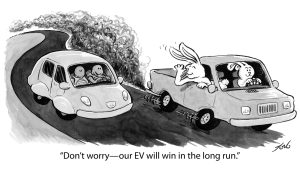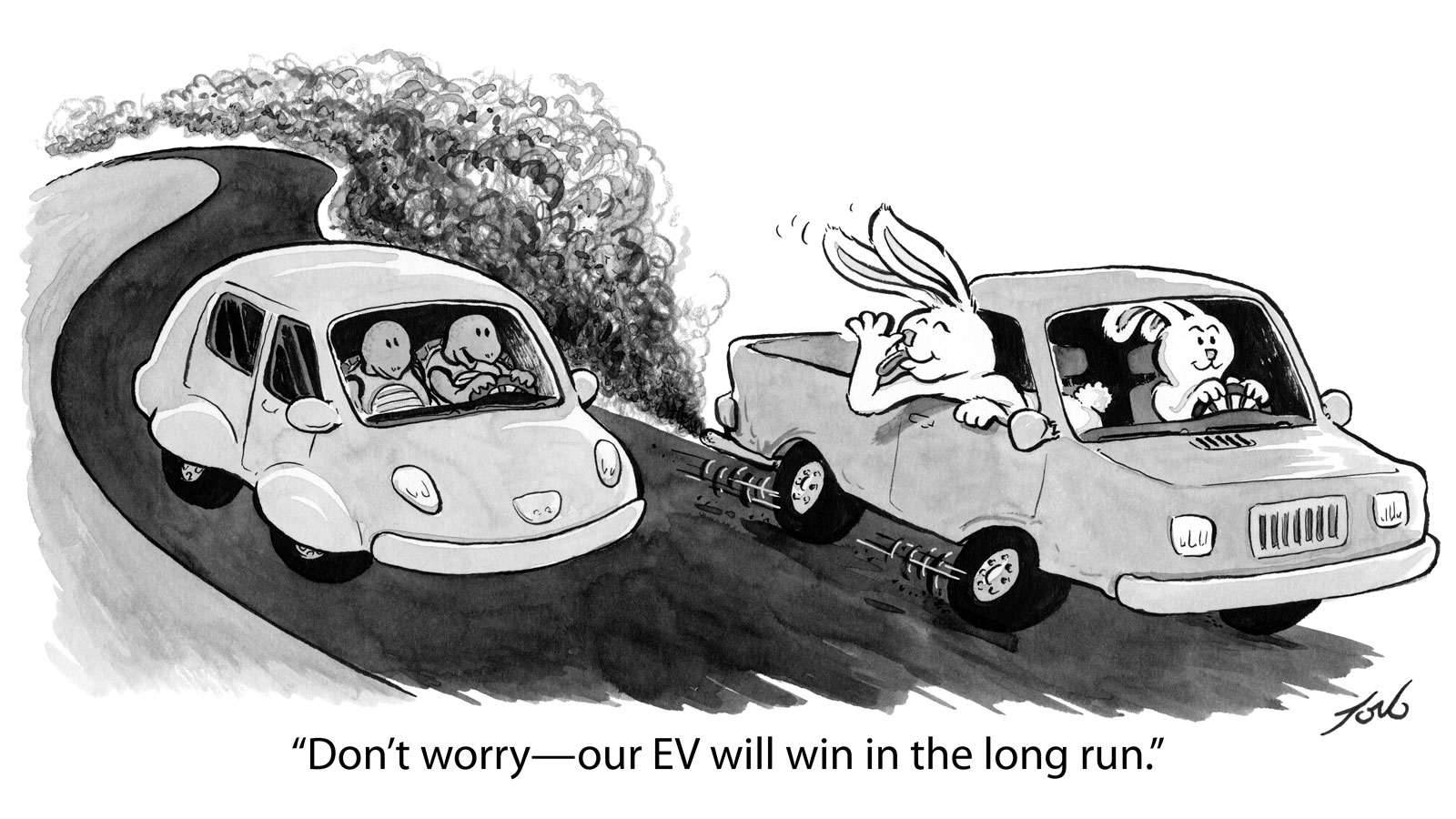Every couple months something pops into my news feed or email about how bad or expensive Electric Vehicles (EVs) are compared to the olde Internal Combustion Engine (ICE machines). (See cartoon from Yale Climate Connection Don’t be fooled: Electric vehicles really are better for the climate.)
One that popped up was from a very biased web site (can’t call it a magazine or journal). The cost for EVs to operate were $17 per gallon, equivalent. It relied on an actual study, and then changed out all the facts.
First, it assumed that you only charge away from home, never at home where it’s much cheaper. Some 99% of EVs are charged at home or (free? at the office) almost all the time. By this assumption, it would assume that the home did not use solar panels which would make the home charging costs even cheaper. Then, they added in all possible externalities for EVs including government subsidies. Wah-la, the magical cost per gallon for EVs is 5 to 8 times ICE machines. (non-news site intentionally not cited)
Why then, wouldn’t the ICE machine side of the equation include government subsidies to oil and gas. Several studies show that coal, oil & gas get at least $1T in subsidies every year, and the equivalent of about $15T including indirect subsidies and extenalities.
If you really want to know the comparison between EVs & ICE vehicles, look at SkepticalScience: https://skepticalscience.com/evs-really-better-climate.html … they provide some of the best sources and best analysis. Because of the cost of production (an EV can weigh twice an ICE because of the batteries), it takes about 22 months before breakeven — emissions-wise. But after that the emissions are massively less for the EV. Figure about $1 per gallon equivalent.
If you want to do an analysis of an EV and an ICE machine, consider how you will use the vehicle and check out these sources.
- ChargEVC: https://chargevc.org/ev-calculator/
- US Department of Energy: https://afdc.energy.gov/calc/
Total Cost of Ownership is a big question as well. The raw materials to make each type of car, where it is made, shipping, etc. There are a few sources that work on this. (Sites/sources on lifetime costs tend to be overly simplified or overly complicated.)
Dealers don’t like EVs because there’s not really any maintenance. No urgent need to see the customer every 6 months to 1 year. No oil to change, no belts to replace. Only fill the windshield washer tank. The brakes have low usage because of regenerative power is used to slow the vehicle by generating power back to the batteries. The dealers will continue to lose touch with their customers, and the trade-in that comes with it.
But the big reason for going EV is making a conscious and continuous effort to move away from fossil fuels. Fossil fuels are not sustainable. The air pollution from burning coal, oil and gas causes health issues and premature deaths of millions of people worldwide every year. To move toward sustainable solutions, we have to move away from those that aren’t.
Two points that often come up is: 1) Renewable Energy (RE); and, 2) electric mix for the power grid and sources of materials like lithium & cobalt for EV. Renewable energy is growing at crazy rates and it is consistently far cheaper (even with battery augmentation) than coal, oil or nuclear. Battery technology (and such) will continue to improve, much like computer chips and hard drives. Products continue to be built with full life cycle designs so the materials in EVs will (soon) be completely recycled.
We need to electrify everything to reduce pollution and greenhouse gases. It took 120 years to build a world economy powered by coal, oil, gas, nuclear and hydro. Over time we need to completely replace fossil fuels. Many people thought we could simply wait until we started to exhaust the (readily available) supplies of fossil fuels and high prices would recalibrate the economy toward more sustainable methods of power and transportation. Waiting another 20, or even 5 years, to act is no longer an option.
#EV #BreakingTheICE #Renewables #RE100 #CarbonEmmissions #CarbonFootprint


